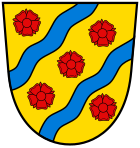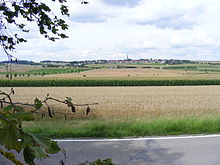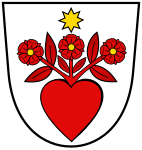Starzach
| coat of arms | Germany map | |
|---|---|---|

|
Coordinates: 48 ° 26 ' N , 8 ° 49' E |
|
| Basic data | ||
| State : | Baden-Württemberg | |
| Administrative region : | Tübingen | |
| County : | Tübingen | |
| Management Community : | Rottenburg am Neckar | |
| Height : | 526 m above sea level NHN | |
| Area : | 27.82 km 2 | |
| Residents: | 4363 (December 31, 2018) | |
| Population density : | 157 inhabitants per km 2 | |
| Postal code : | 72181 | |
| Primaries : | 07483, 07457, 07478, 07472 | |
| License plate : | TÜ | |
| Community key : | 08 4 16 050 | |
| Community structure: | 5 districts | |
| Address of the municipal administration: |
Hauptstrasse 15 72181 Starzach |
|
| Website : | ||
| Mayor : | Thomas Noé | |
| Location of the municipality of Starzach in the Tübingen district | ||
Starzach is a municipality in the district of Tübingen in Baden-Wuerttemberg ( Germany ). It is located about 20 km southwest of Tübingen .
geography
Geographical location
Starzach is located on the Neckar between Rottenburg am Neckar and Horb am Neckar . Two parts of the community (Börstingen and Sulzau) are located in the Neckar Valley , three others (Felldorf, Bierlingen and Wachendorf) south of it.
The two rivers Starzel and Eyach delimit the municipality.
Due to its charming location, Starzach is also known as the Tuscany of the Tübingen district .
Community structure
The community of Starzach consists of the formerly independent communities of Bierlingen , Börstingen , Felldorf , Sulzau and Wachendorf . The village of Bierlingen and the Neuhaus homestead belong to the former municipality of Bierlingen. The former municipality of Börstingen includes the village of Börstingen with the castle ruins of Siegburg Castle and the houses at the Eyach train station, carbon dioxide plant, Lohmühle (today according to the Eyach sign) and Wilhelmshöhe. The village of Felldorf and the Honorsmühle, which was demolished in the 1990s and rebuilt in 1810 and named after its builder, are located in the area of the former municipality of Felldorf. The village of Sulzau and the castle and homestead of Weitenburg are in the area of the former municipality of Sulzau. The village of Wachendorf and the Burgmühle house are in the area of the former municipality of Wachendorf.
In the municipality some are Outbound , now-defunct villages. Zuckenhausen probably existed in the area of the former municipality of Börstingen and in the area of the former municipality of Sulzau in the 14th century. The village of Kaltenhausen, mentioned in 1747 as Karrenhausen , was located in the southwest of the former municipality of Felldorf . Above the village of Sulzau, on the Neckar, lies the abandoned village of Neumühle. In the south of the former municipality of Wachendorf is the abandoned village of Bechhausen, which is indicated by a field name.
history
Until the mediatization in 1805, the five formerly independent communities of Starzach were under the rule of imperial knight families. Bierlingen, Felldorf and Wachendorf were ruled by the Barons von Ow, among others, with their seat in Wachendorf Castle , Börstingen and Sulzau belonged to the dominion of the Weitenburg , which in the 18th century was with the Barons Raßler von Gamerschwang after many changes of ownership. In 1805 the localities came under the authority of the Electorate of Württemberg , from which the Kingdom of Württemberg emerged in 1806 . With the implementation of the new administrative structure , the five villages were assigned to the Oberamt Horb .
As a result of the district reform in Württemberg during the Nazi era , the villages became part of the Horb district in 1938 . In 1945 they became part of the French zone of occupation and therefore came to the newly founded state of Württemberg-Hohenzollern , which was incorporated into the state of Baden-Württemberg in 1952.
The community of Starzach was formed on January 1, 1972 from the three communities of Bierlingen, Felldorf and Wachendorf. The name Starzach was derived from the two rivers Starzel and Eyach . On June 1, 1973, the smallest suburb of Sulzau came to Starzach and on February 1, 1974, Börstingen completed the new community after a referendum.
The five districts came as part of the district reform on January 1, 1973 from the dissolved district of Horb to the district of Tübingen.
The two rivers and five flowers - from the Sulzau coat of arms - for the five parts of the municipality can be found in the municipal coat of arms.
The seat of the municipal administration is in the district of Bierlingen.
- The coats of arms of the former municipalities
politics
Municipal council
In Starzach, the municipal council is elected using the spurious sub-district election. The number of local councils can change due to overhang mandates . The municipal council in Starzach has 16 members after the last election. The local elections on May 26, 2019 led to the following preliminary final result. The turnout was 65.85% (2014: 53.3%). The municipal council consists of the elected voluntary councilors and the mayor as chairman. The mayor is entitled to vote in the municipal council.
| Future of Starzach (ZS) | 9 seats | 54.65% | 2014: 0%, 0 seats |
| Citizens' Representation Starzach (BVS) | 5 seats | 31.34% | 2014: 56.2%, 8 seats |
| Independent List Starzach (ULS) | 2 seats | 14.01% | 2014: 0%, 0 seats |
| Free Citizen Starzach (FBS) | 0 seats | 0% | 2014: 43.8%, 7 seats |
mayor
The mayor is elected for an eight-year term. The current mayor Noè was re-elected on January 29, 2012 with 67.8% of the vote against two opposing candidates.
- 1972–1982: Josef Oswald
- 1982–2003: Manfred Dunst
- since 2004: Thomas Noé
Community partnerships
Since July 1992, Starzach has been on friendly terms with the French association of municipalities Bocage-Gatinais near Paris , i.e. the municipalities of Blennes , Chevry-en-Sereine , Saint-Ange-le-Viel , Villemaréchal and Ville-Saint-Jacques .
traffic
The next traffic station is the Eyach train station on the Tübingen – Horb railway line .
Culture and sights
Natural monuments
- Neuhaus oak with a BHU of 7.20 m (2015).
Buildings
Sons and daughters of the church
- Hans von Ow (1843–1921), born in Wachendorf, member of the Reichstag and Landtag
- August Mayer (1876–1968), born in Felldorf, gynecologist and university professor
- Ulrich Noll (1946–2011), born in Börstingen, dentist and politician (FDP), member of the state parliament, former chairman of the FDP / DVP parliamentary group in the state parliament of Baden-Württemberg
Starzachfest
The Starzach Festival takes place every two years, alternating between the five villages .
Stare lag
The 11.2 km long Starzachlauf takes place annually in Starzach-Wachendorf. In 2011 Judith Wagner won the women's competition.
Individual evidence
- ↑ State Statistical Office Baden-Württemberg - Population by nationality and gender on December 31, 2018 (CSV file) ( help on this ).
- ^ Tübingen district
- ^ The state of Baden-Württemberg. Official description by district and municipality. Volume VII: Tübingen administrative region. Kohlhammer, Stuttgart 1978, ISBN 3-17-004807-4 , pp. 150-152.
- ^ Federal Statistical Office (ed.): Historical municipality directory for the Federal Republic of Germany. Name, border and key number changes in municipalities, counties and administrative districts from May 27, 1970 to December 31, 1982 . W. Kohlhammer, Stuttgart / Mainz 1983, ISBN 3-17-003263-1 , p. 529 and 539 .
- ↑ Neuhaus oak in the directory monumental oaks . Retrieved January 10, 2017











